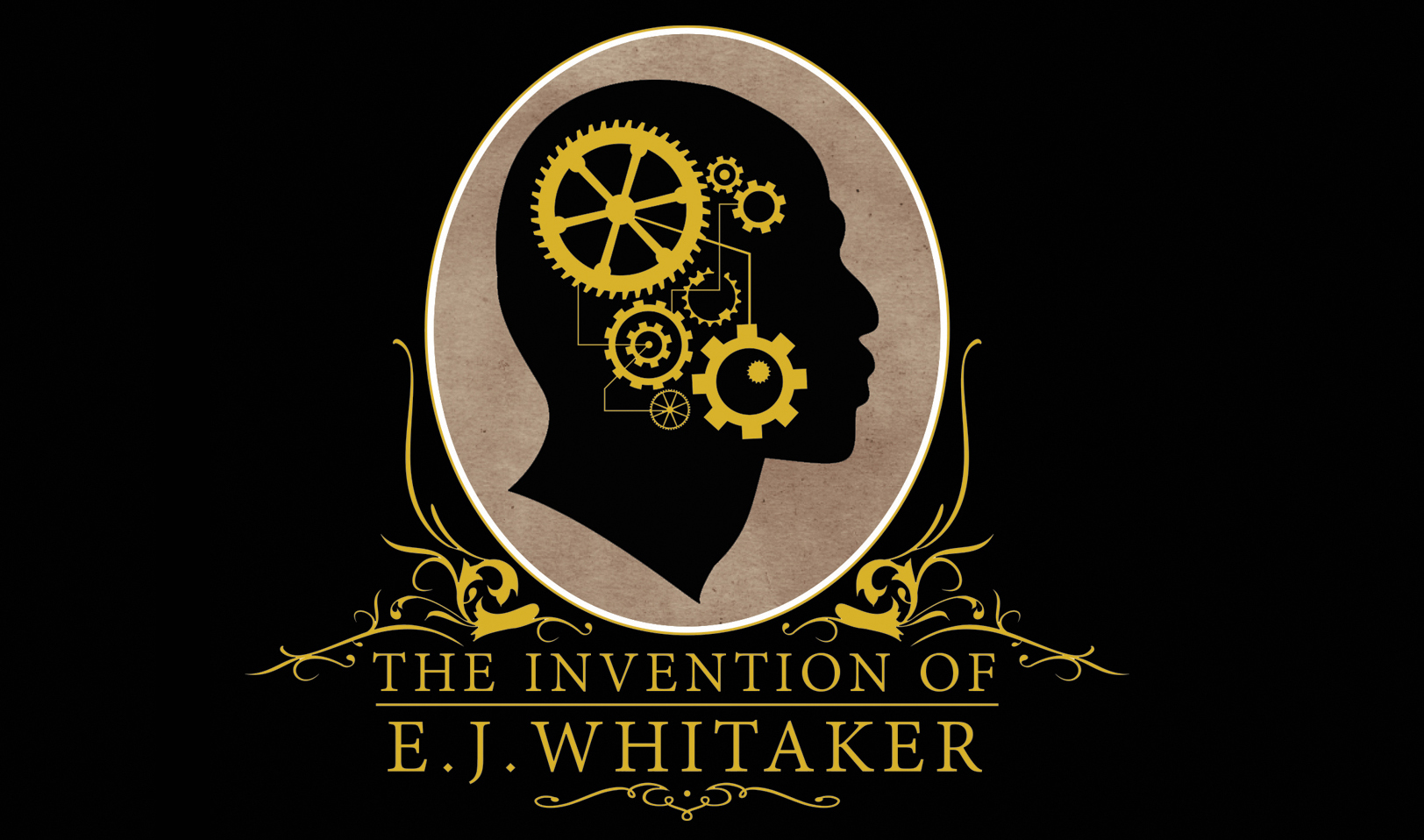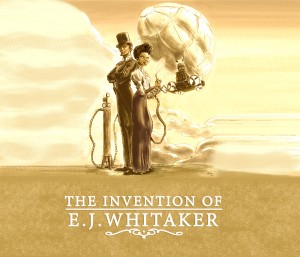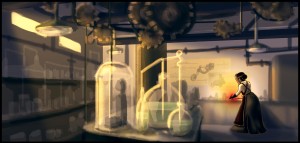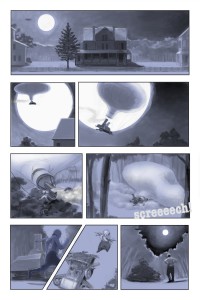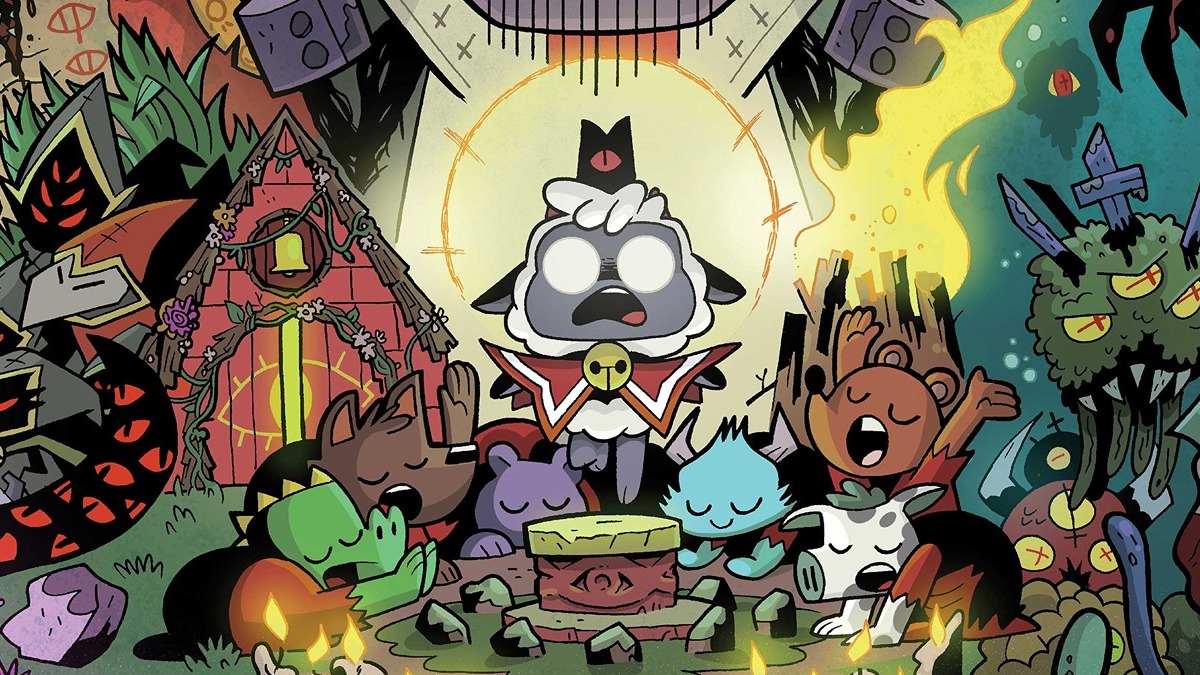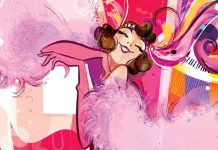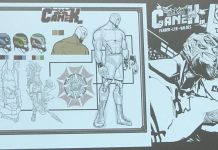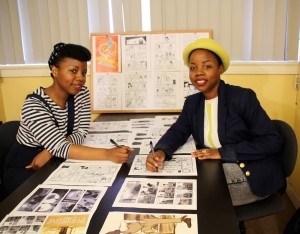
Shawnee and Shawnelle Gibbs it seems were each destined to be creative. Both writers and illustrators, these sisters are the founders of Reel Republic, the production umbrella for their works. The team boasts credits such as the award winning animated short Ravishing Rasberry, popular online series Adopted by Aliens and Old Ladies Driving, and the young adult comic book series Fashion Forward.
One of their latest endeavors is a soon to be comic book entitled The Invention of E.J. Whitaker. This early 20th century Steam Punk inspired Historical Fiction tells the story of our heroine Ada Turner and her struggles in the early 20th century to become move away from being an apprentice taking on the role of an inventor.
I was fortunate enough to talk with the imaginative pair and ask them a few questions about themselves and their latest project.
Looking at your website, your background in story telling goes back quite a while. What got the both of you interested in the same field?
SHAWNEE´: I think somehow we always knew we’d both work in creative fields. Though Shawnelle and I originally took up separate disciplines of study in college—I was originally interested in pursuing Journalism and Shawnelle started out in Fashion—we came together after a couple of years and both studied Cinema at San Francisco State University. We’d been writing stories and drawing collaboratively since we were tiny little ones but it was in college that we got exposed to the tools used to create animation and man did we really get into it. We started creating cartoons using software like Poser and Bryce and later Flash and After Affects. We’d always had a love for telling stories visually but our college years really exposed us to new and exciting ways to do it. We’ve both been hooked ever since.
Did you really sell your hand drawn comics around your school? How did that go for the two of you? What did you learn from that experience?
SHAWNELLE: Yeah, we’d sale little hand-made comics for a quarter around our elementary school, mainly because it was a great way to make candy money. We’d cut and staple pieces of composition paper together into small books and create 3-panel stories about these happy anthropomorphic characters. I think the business side of things started because kids around school would always ask us to draw them a book, and to keep up with the demand a 25 cents charge was added. We didn’t even know what supply and demand was but somehow we were putting it into practice.
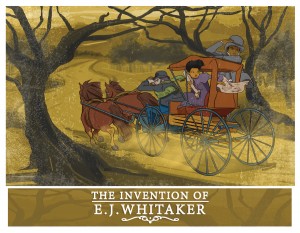
SHAWNEE´: I really believe it’s because we caught the bug so early. We’d write and create so many stories for fun in our youth that now it’s just habit and instinct. I’ll have an idea in the shower, or while driving, or in a cafe. I’ll just jot notes down on my cell for future use in a story. Then I’ll think would that be a good comic? Maybe it might be better animated…or maybe better as a live-action film? We’re always thinking of ideas and new and different ways to tell narratives. I’m sure I’ll be a ninety year old woman in a nursing home jotting stories on my dinner napkin someday.
What were/are some of your inspirations (either authors or individual works)?
SHAWNELLE: One of our biggest inspirations is the late sci-fi novelist Octavia E. Butler. We discovered her novel “Kindred” in high school and just sort of became her unofficial disciples. She definitely introduced us to the idea that black women could write contemporary, science fiction stories set in worlds and neighborhoods that felt familiar with characters—female heroines—who could be us. We just went gaga over her and credit Octavia with the reason why we’ve been able to explore the types of stories we’re telling today.
As African-American women, tell us your impression of getting into the industry.
SHAWNEE´: I think the comics and entertainment industry’s definitely doing a good job of changing and realizing that audiences are content-starved
for more stories about people of color and women. I think the industry has been making great strides in putting more diverse stories out there but there are still many roadblocks for creators of color to help tell those stories—mainly because of access. People in charge of hiring at comics companies often hire who they know, are familiar with, or have worked with before, which means the usual roster of white male writers and artists telling stories about diverse groups, rather than diverse writers and artists having a collaborative hand in shaping those stories as well. I think things are very, very slowly changing but until diverse writers and creators (and even Editors and Executives) are getting more jobs in the industry, I think we’ll still have a very long way to go.
In today’s environment, how would you say the diversity is in the creative industry?
SHAWNELLE: It’s tough because when you think of creative industries, you think progressive, forward-thinking individuals are at the center of it, and in some respects they are, but institutionalized barriers are real and run very deep. As people who work independently and also freelance creatively for a living, the sorts of opportunities available to some of our peers that are not based on merit or hardwork is pretty disheartening, but it also makes us work even harder to make sure that the next generation doesn’t have to toil and struggle so hard for an equal shake. It’s why we strive both creatively and in the professional environment to do our best, not only so we can break barriers for ourselves, but support and encourage other creators of color, women, and youth.
For your latest project, “The Invention of E.J. Whitaker,” what were your motivations in taking on this project?
SHAWNEE´: We’d been researching a couple of African American vaudeville performers who lived during the early 1900s for a script we were working on, and after reading lots of newspapers and books from the period, we realized there were a lot of pretty awesome people living and existing in 1901. We’ve been really into women and science the last few years and had been writing our time-travel comic “Fashion Forward,” at the same time we were developing the idea of ‘E.J. Whitaker.’
So we thought what might happen if a young African American inventor created the first flying machine in 1901? Oh boy. What would people think? They’d probably lose their minds. As both a female inventor and person of color, would she even be taken seriously? That became the genesis for “The Invention of E.J. Whitaker.”
What were some of the challenges/hurdles you encountered during the comic’s process?
SHAWNELLE: I think the biggest hurdle we encountered was whether to try and fund the comic on our own or use a crowdfunding platform like Kickstarter. We decided late last year to crowd fund and though we were really worried about anyone being interested in a Sci-Fi, Adventure-Romance with Steampunk elements featuring African American leads but we have been blown away by the support. We started our Kickstarter campaign 27 days ago and as of today, the comic is over 170% funded on Kickstarter and we still have a few days left.
Why a comic and not a book?
SHAWNEE´: Comics are such a beautiful and visual medium that we really wanted to have readers see the world and characters of “The Invention of E.J. Whitaker,” and feel the adventure leaping off of the panels. There’s a specialness about comics in that when you open a book, the characters almost become living, breathing entities. The worlds are tangible and lush and what writers describe in words have been brought to life by the hand of an artist. It’s really a beautiful experience that the story felt perfect for.
The examples of the comic’s artwork are beautiful and highly detailed. Can we expect the rest of the comic to follow this same kind of work?
SHAWNELLE: Yes, our artist Mark Hernandez, who we’ve collaborated before on animation will pencil and ink the pages. His are is timeless and we think it really compliments the time period nicely. Hasani McIntosh, who we’ve also worked with in animation is our colorist and our cover artist is Earl Womack, who rendered the beautiful horse and carriage artwork.
What do you hope to say or accomplish with this comic?
SHAWNEE´ We hope to share a very beautiful adventure story with readers and introduce a new heroine for audiences, through our character Ada, who’s a really intelligent young woman who knows how to roll up her sleeves and handle herself when the going gets rough.
We know that women and people of color are vastly underrepresented in the STEM world (Science, Technology, Engineering and Mathematics) so we hope that seeing Ada navigate flying machines as early as over a century ago, might inspire a new generation of innovators today.
When can we expect to see “The Invention of E.J. Whitaker to hit stores?”
SHAWNEE: We’re aiming to have the first issue of “The Invention of E.J. Whitaker” complete by this December. So we’ll let you know when Ada and the gang take flight!
The Invention of E.J. Whitaker looks like it will highly imaginative and a worthwhile read. With a few days left on their Kickstarter, I highly encourage you to take a look at their campaign page and contribute. Follow the link at: https://www.kickstarter.com/projects/754556488/the-invention-of-ej-whitaker


